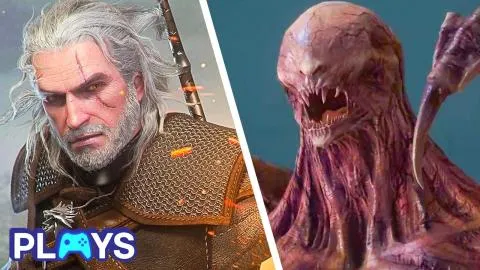Witcher Monsters and Where They're From in Real Life | MojoPlays

#7: Crones
The Crones are a trio of witches of unknown species who inhabit and essentially rule the swamps of Velen in Temeria. At one point they abduct Ciri and the three sisters can be battled by her; leading to the deaths of two of them. While trios of witches are fairly common in pop culture, most, including the Crones, get their origins from the Weird Sisters from the Shakespeare play “Macbeth.” The Crones’ bestiary entry even refers to a fictional play “Macveth.” The Crones’ monstrous appearances are also inspired by the Baba Yaga, a recurring figure in Slavic mythology that takes the form of a warped old woman often capable of magic.
#6: Vampire
Vampires are a well-known mythological creature from the real world, and in “The Witcher” they’re equally famous, but not quite as homogenized as “real” vampires have become. In the world of “The Witcher,” vampires come in a wide variety of forms, with the higher vampires being more akin to the most famous depiction of the bloodsuckers, with human-like forms such as in “Dracula,” albeit able to transform their appearance to a more bestial one. Others include the bat-like Nosferat, whose origins align with the real world Nosferatu, as well as the Alps, whose preferred method of feeding on the sleeping mirror their Germanic counterparts. There are too many varieties to list them all here, but regardless, vampire lore is deep no matter where it’s found.
#5: Godling
Godlings resemble children, but while they can be childish in their love of mischief, they’re usually far older than kids. Despite causing trouble, these intelligent beings can be befriended in “The Witcher” series, provided certain choices are made. The Polish term for godlings is bożątko, which is derived from uboże, a mythological household spirit, akin to a hobgoblin or púca; a common mythical creature throughout Europe. Godlings are also often tied to a specific territory like their real world inspirations, but unlike uboże, they seem much fonder of body paint.
#4: Succubus
Succubi and their male counterparts incubi are horned, humanoid creatures that are very attractive and who feed on the energy of humans, often through dreams, wherein they seduce the sleeper, which can result in death if the…ahem…exertion…is too much. The succubi in “The Witcher” are capable of magic and are quite physically strong. Yet, unlike most monsters they can be reasoned with…or at least seduced themselves. Succubi and incubi appear in many cultures’ mythologies and generally resemble those found in “The Witcher” series, albeit with more of a demonic origin.
#3: Berserker
Also known as werebears, berserkers are warriors from Skellige who can transform into bears. Berserkers can either be born or made through certain potions or curses. Whatever their origins, they’re still vulnerable to silver. In Old Norse, berserker literally means “bear coat,” and they were held to be uncommonly strong and fierce fighters. The origin of their connection to bears may be due the fact that many wore bear skins to show their prowess, or else that they worshipped bears as part of a bear cult. Or it could just be that their ferocity evoked the animal so much that people thought they could turn into them.
#2: Leshen
Forests in “The Witcher” games can be terrifying, in no small part due to leshens. Blending in with the trees around them, albeit with a deer skull instead of a head, these terrifying beings will attack Geralt and the player with tree limbs and roots; while also summoning the beasts of the forest to aid them. Their names and home environs are derived from the leshy, a kind of Slavic mythological figure who guards forests, but not quite as violently as leshens do; being more prone to mischief and misdirection.
#1: The Wild Hunt
In “The Witcher”’s third game, these titular foes are a ghostly army of elves from another realm who are believed to be a sign of death and conflict. In actuality, they seek slaves to serve them in their dimension and also show an interest in Ciri’s Elder Blood. In European mythology, the Wild Hunt is actually much the same in its broad strokes, acting as a supernatural harbinger of death and doom; with its members often said to be the souls of dead warriors. The “real” Wild Hunt is also associated with the Norse god Odin, though it has had many supposed leaders. Its members are sometimes thought to be elves as well, although whether they’re from another world is unclear.
